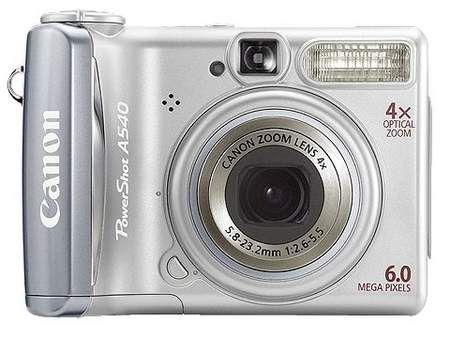Canon’s "A" PowerShot range of digital compacts are aimed at the more consumer end of the market, unlike the company's more stylish and arguably more sophisticated IXUS counterparts. Nevertheless, just because the new A540 may be built without the enthusiast in mind, it does not mean it lacks a powerful photo punch in terms of both specification and shooting features.
Our quick take
The Canon PowerShot A540 provides plenty of meat for those wishing to buy and use an easy to operate camera but still want room to grow, as they get better at taking their snaps. So, whether you’re simply snapping or taking more studied shots, the 540 is a nice, reliable digital compact and while it may not hold the pinnacle of performance (that’s still Fuji’s crown at the moment) in terms of noise control, it is more than capable of producing some very nice images indeed. In short, it is worth a look.

Canon PowerShot A540 digital camera - 4.0 / 5
| FOR | AGAINST |
|---|---|
|
|
The 540 includes Canon’s DIGIC II processor (as found in the company's top D-SLR cameras) and it provides the number crunching power to quickly process snaps and feed them onto the SD/MMC external storage. DIGIC also makes power use more frugal making the most of the camera's dual AA battery power, the cells for which sit alongside the SD or MMC card under a flap on the camera’s base.
Other features of note include a nine-point AiAF focus set up that is both fast and accurate in use. You also get iSAPS technology which uses information about the scene you’re about to shoot to ensure the camera is set up to make the most of the subject matter; it’s a sort of expert program, one designed to help you get the most out of your photography. Overall, then camera is both nimble and nippy to use.
A neat 4x optical zoom lens provides a respectable maximum zoom focal length of 140mm but a more modest wide-angle end at 35mm (both in 35mm film terms) with maximum aperture settings of F/2.6 to F/5.5. The lens is crisp but the extreme periphery of the field of view suffers from a lack of sharpness, most noticeable in the corners of an image.
In terms of handling, the 540 offers a blocky but nice to hold shape in the hand with a prominent hand grip that houses the aforementioned AA cells and memory card and plays host to the combined shutter release and zoom control.
A large mode dial allows you to select from a comprehensive range of shooting options, from the ubiquitous point and shoot Auto mode through the aperture and shutter priority settings to a fully manual mode. Three subject programs are on offer on the mode dial: Portrait, Landscape, and Night Portrait modes, typically the most popular ones and hence their placement here.
These three are backed up by a further nine settings including a funky Colour Accent mode that picks one colour from an otherwise monochromatic scene (see the illustrative images to get an idea what I mean). Kids and Pets are catered to as well and there’s an Indoor and a Foliage setting. As with all the scene modes each optimises camera settings to get the most from the subject matter.
Sensitivity is always an issue with digital cameras, or at least the noise associated with higher ISO settings, and the 540 provides a range of sensitivity settings from ISO 80, 100, 200, 400 and a top setting of ISO 800. Noise is noticeable in images at ISO 400 and above with ISO 800 proving problematic in shadow areas and areas of one colour, such as a clear blue sky.
However, the large 2.5-inch screen is good to use in all but the brightest conditions, but the addition of an optical viewfinder helps out tremendously and also will help reduce power usage as you can toggle the display off if you need to and still be able to compose a shot.
Other key controls are placed alongside the screen providing a fairly standard layout, a four-way control, Display and Menu buttons, plus a Function button sat centrally inside the four-way control. You can quickly access Exposure Compensation via a dedicated button on the camera’s back; it can be applied in any setting as well, a nice touch indeed.
Image quality is good overall (noise issues notwithstanding) and given the target market, easily good enough for most users. The 540 is easily able to provide prints up to, and over A4, there’s bags of detail on show. The metering is excellent, particularly the evaluative metering set up; white balance control is good too, particularly in the Auto setting. White balance can be fine tuned or custom set to match the actual lighting, which can provide a richer looking colour and provide a more neutral white.
To recap
The Canon PowerShot A540 is
